List of Authors
>>About this blog
Recent blog post
|
[O'age]
February 28, 2017 18:00
In the park, I took the following photo on a chilly day when the snow of the Snow Festival remains.
Siebold (1796-1866)
Philip Franz von Siebold arrived in Nagasaki in July 1823 as a Dutch trading house doctor, and was active in opening a private school in Narutaki, Nagasaki, alongside medical treatment.
On the New Year of the same year, he headed to Edo with the director of the trading house, stopped at Nagasakiya in Nihonbashi on March 4, and before leaving on April 12, interviewed Dutch scholars in Edo and had a great influence. However, after the Siebold incident occurred in 11 years, he was expelled from Japan in December. He later returned to Japan as an advisor to the Shogunate in 1859 (1859), but soon returned home and died in Munich.
His guidance in Edo was greatly contributed to the development of Edo Dutch studies. This land is the birthplace of Edo Dutch studies, and his daughter Ine, who received in Nagasaki, opened a maternity hospital in Tsukiji, and foreign settlements were established in this area from the early to mid-Meiji era. Therefore, he builds his bust here to reward his understanding of Japan and his achievements as a bridge between Japan and the Netherlands.
Chuo-ku Board of Education
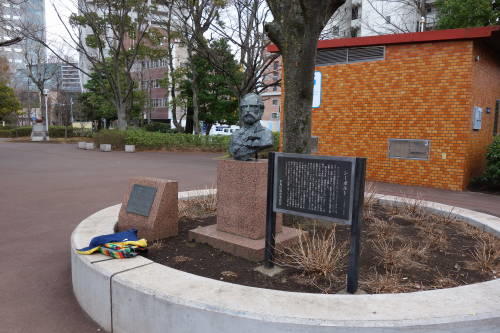
One of the reasons for the bust here is the fact that Siebold's daughter, Ine, who received a daughter in Nagasaki, opened a maternity hospital in Tsukiji.
I looked for a specific address, but I didn't know. I'll read a little novel. It can be seen that "Ine" was a person who lived as a doctor in the turbulent era of the Meiji era from the end of the Tokugawa period to the Meiji era. In addition, there are many famous historical figures, the depiction differs depending on the writer, and there are interesting things.
"Ine" was born in Nagasaki in 1827. He studied obstetrics and Dutch studies, and opened a maternity hospital in Tsukiji in 1870 (closed in 1875). In 1889 (1889) Ine moved to Tokyo from Nagasaki again and lived in Azabu with her daughter Takako. He died in 1903 (1903), 76.
[O'age]
January 23, 2017 18:00
I visited Hatsune Mori Shrine, which has been worshiped as a god of business prosperity enshrined in Japan's No. 1 textile wholesaler district, a local god (the guardian of Bakurocho, Yokoyamacho, and Higashinihombashi). On the first floor, there are gateposts of Asakusa Gomon excavated during the construction of the Sobu Express Line. Below, "P95-96 of Monoshiri Encyclopedia".
Hatsune Mori Shrine
The shrine built in the building was founded in the Kamakura period.
It was said to have been founded in the Kamakura period, and was enshrined here, but when building a county mansion near the current Bakurocho, it was relocated to the headquarters (now Sumida-ku) opposite the Sumida River. Rebuilt in 1948 (1948), main hall is built on the second floor of the building and has a torii gate in front of the building. (Higashibashi 2-27-9)
Related Photos and their descriptions
The present Hatsune Mori Shrine in Higashinihombashi
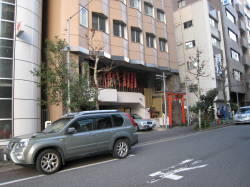 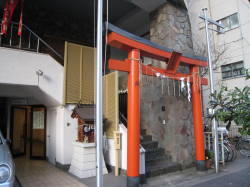
Exhibition of gateposts of Asakusa Gomon
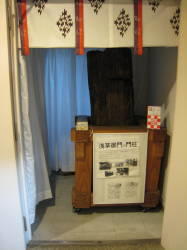 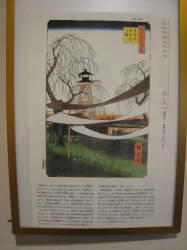
Chuo-ku Board of Education explanation board of "Gyodai Yashiki Ruins" in Asakusabashi and Nansei Hashizume
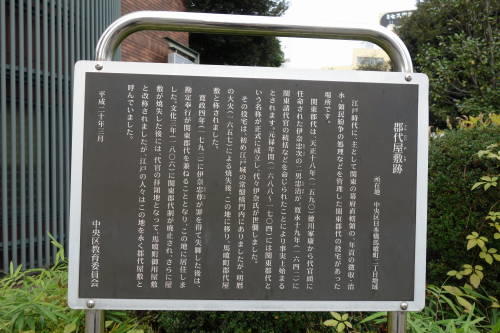
Hatsune Mori Shrine and head office at the headquarters located on the opposite bank of the Sumida River (now Chitose, Sumida-ku).
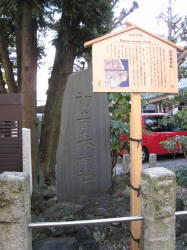 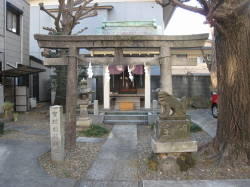
[O'age]
December 28, 2016 09:00
Here are some explanation boards that are not listed in the Monoshiri Encyclopedia.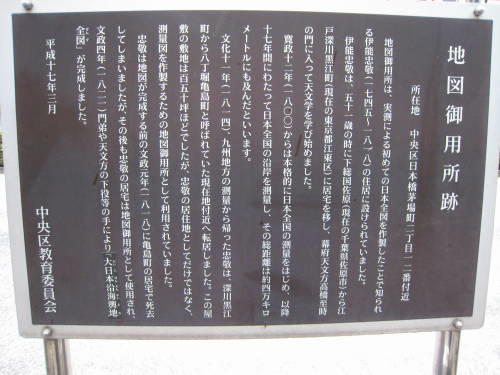
Location Near 22-22, Nihonbashi Kayabacho, Chuo-ku
The map office was located in the residence of Tadataka Ino (1745-1818), known for producing the first full map of Japan based on actual measurements. Tadataka Ino moved his home from Sahara, Shimousa Kuni (currently Sahara City, Chiba Prefecture) to Kuroe-cho, Edo Fukagawa (currently Koto-ku, Tokyo) at the age of 51, and entered the gate of the Shogunate Astronomy Yoshitoki Takahashi to study astronomy. I started. From 1800 (1800), he began surveying all over Japan in earnest, and over the next 17 years, surveying the coasts of Japan, and it is said that the total distance was about 40,000 km. In 1814 (1814), Tadataka Ino, who returned from surveying in the Kyushu region, moved from Kuroe-cho, Fukagawa to the current location, which was called Hatchobori Kamejima-cho. The site of this mansion was about 150 tsubo, but it was used not only as a place of residence for Tadataka Ino, but also as a map place for making survey maps. Tadataka Ino died at his home in Kamejima-cho in 1818 (1818) before the map was completed, but Tadataka Ino's home was used as a map servant, and in 1821 (1821) The "Dainippon Seaside and Map" was completed by the members of the astronomy. March 2005 Chuo-ku Board of Education
Monument of the residence of Fukagawa Kuroe-cho (currently on the sidewalk near Monzennaka-cho, Koto-ku) in Tadataka Ino
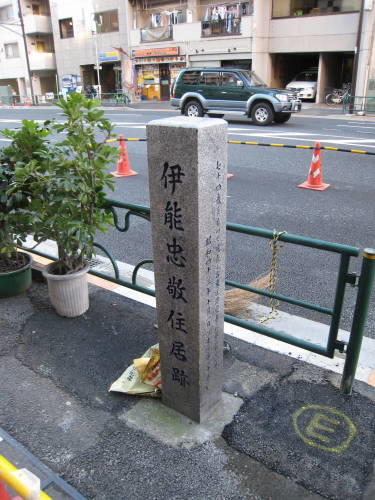
The grave of Tadataka Ino is located at Gensoku-ji Temple in Taito-ku, and is lined up with the grave of the time when he was a teacher.
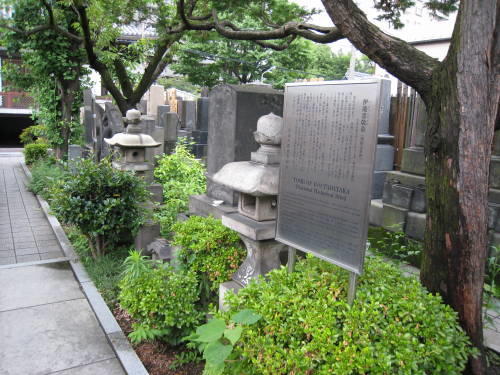
[O'age]
Nov. 30, 2016 14:00
While walking along Shin-ohashi-dori St., I saw the display of "Tokanbori-dori", so at a later date, look for the display of the old moat traces. I managed to find an explanation board for "Inaribori Ruins". There was also an explanation board for "Gyotoku Riverside" nearby. It is not listed in the Monoshiri Encyclopedia, so I will introduce it in the following photo.
Tokanbori Street
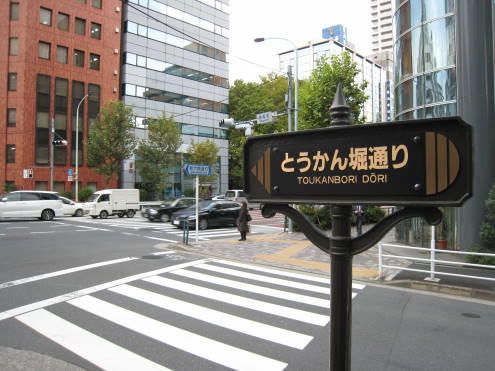
Explanation board (Chuo-ku Board of Education) of the ruins of Inaribori (Tokanbori)

Gyotoku Riverside (Chuo-ku Board of Education)
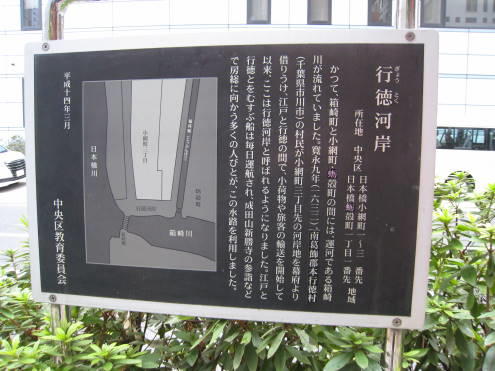
Looking up at the highway above this area, I remember the days when I checked in nearby and went to Narita Airport by bus several decades ago. Hiroshige draws this area with "Mitsumata Wakare no Fuchi".
In addition, there is an explanation board near (northwest direction), "Maison Konosu Founding Land". Compared to the cafe "Maison Konosu" (published on Monoshiri Encyclopedia p26), here it is described as "Western restaurants that also serve as bars". It seems that many famous writers have gathered.

[O'age]
October 27, 2016 09:00
Site of Sadakichi Chiba Dojo
The trace of the dojo of the younger brother of Shusaku Chiba, the founder of the Hokushin Ichito style.
The description of this explanation board (Chuo-ku Board of Education) is not in the text, but the theme of the 9th Chuo-ku Tourism Certification is the Kyobashi area. It is located on the southern sidewalk of Kajibashi Street (2-8 Yaesu).
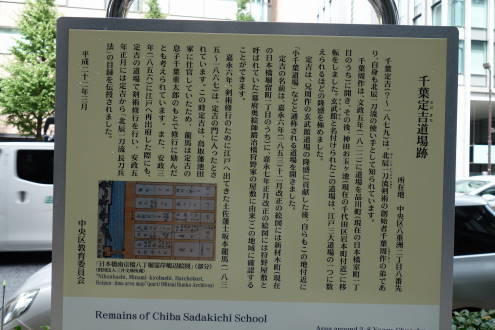
In addition, monuments with photographs and illustrations, such as the history of Kyobashi near the same sidewalk, may this be an object that cannot be overlooked when walking around the city? (It is not from the Board of Education)
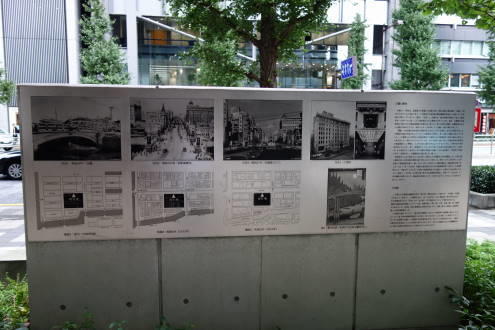
[O'age]
September 20, 2016 16:00
From the viewpoint that it should be a little useful when volunteering, I wanted to learn how to use AED. I have a chance to receive normal lifesaving I at the fire department, so I will report it.
The cost was 1400 yen for the course, 82 yen for the postage stamp of the certificate, and the time was about 3 hours. There are two instructors from the Disaster Prevention Association. Participants are men and women (7+8) in their 40s and 70s.
For the first time after taking the course, I realized that it was not enough to just know how to use AED. Before attending the course, the AED had a voice guide and thought that it would be nice to do it, but I realized that that alone was not enough.
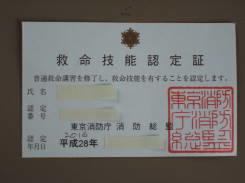 Certificate received at a later date Certificate received at a later date
In order to understand the content, it is best to take a course, but a part is described below.
1. Importance of First Aid If a bystander (person present) gives first aid in the event of an injured person, the life-saving effect will be improved and the progress of treatment will have a positive effect.
2.Bystanders play two important roles, the most important role of rescue,: (1) early reporting of cardiopulmonary arrest to the fire department and (2) primary lifesaving treatment (early cardiopulmonary resuscitation and AED treatment).
3.Life-saving measures are three treatments: cardiopulmonary resuscitation, defibrillation using AED, and airway foreign body removal, which are performed to save the lives of the victim.
Points
①Safety of the surroundings: The victim and myself.
②Ask the people around you for help loudly, call 119 and request the AED to be transported.
③Chest compressions are strong and fast and constant. Treatment with AED.
I understand it.
Lecturers were told that there were many people who work in buildings where many people gather, such as department stores. If you are interested, why don't you take this course? Training using dolls was also a good experience.
|
Links
|

